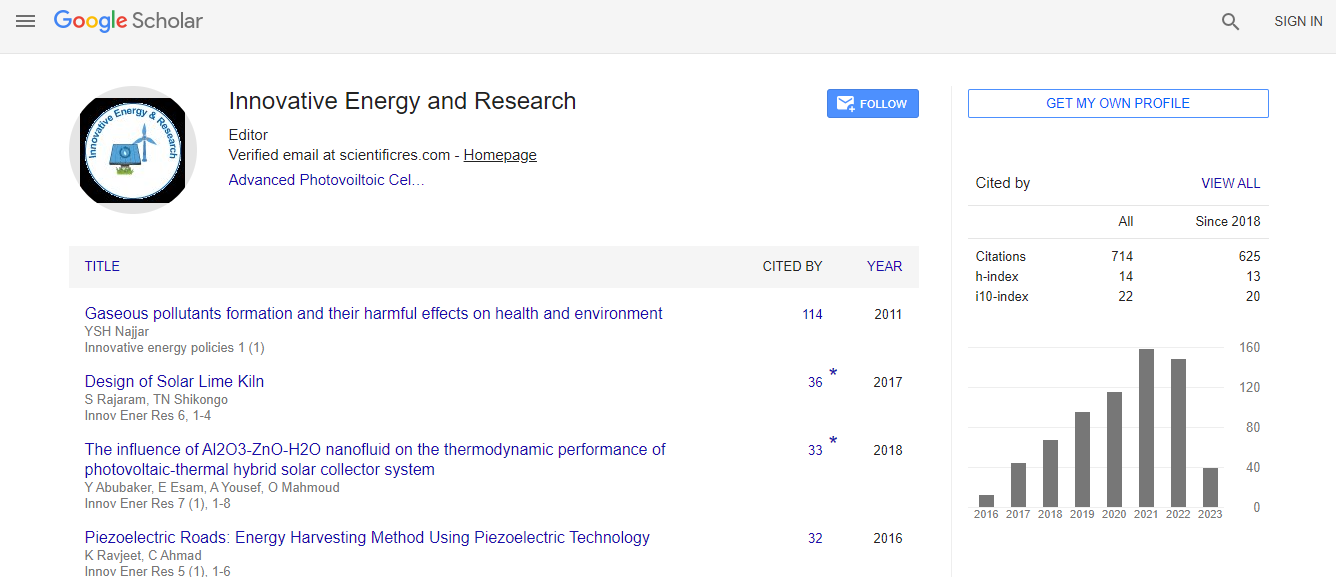Our Group organises 3000+ Global Conferenceseries Events every year across USA, Europe & Asia with support from 1000 more scientific Societies and Publishes 700+ Open Access Journals which contains over 50000 eminent personalities, reputed scientists as editorial board members.
Open Access Journals gaining more Readers and Citations
700 Journals and 15,000,000 Readers Each Journal is getting 25,000+ Readers
Google Scholar citation report
Citations : 712
Innovative Energy & Research received 712 citations as per Google Scholar report
Innovative Energy & Research peer review process verified at publons
Indexed In
- Google Scholar
- Open J Gate
- Genamics JournalSeek
- RefSeek
- Hamdard University
- EBSCO A-Z
- Publons
- Euro Pub
- ICMJE
Useful Links
Recommended Journals
Related Subjects
Share This Page
Graphene-silicon Schottky heterojunctions for optoelectronic applications
20th International Conference on Advanced Energy Materials and Research
Antonio Di Bartolomeo, Giuseppe Luongo, Laura Iemmo, Francesca Urban and Filippo Giubileo
Universita di Salerno, ItalyCNR-SPIN, Italy
ScientificTracks Abstracts: Innov Ener Res
Abstract
The graphene/silicon (Gr/Si) junction has been the subject of an intense research activity both for the easy fabrication and for the variety of phenomena that it allows studying. It offers the opportunity to investigate new fundamental physics at the interface between a 2D semimetal and a 3D semiconductor, and holds promises for a new generation of graphene-based devices such as photodetectors, solar cells and chemical-biological sensors. A Gr/Si junction with defect-free interface exhibits rectifying current-voltage (I-V) characteristics, which are the result of the formation of a Schottky barrier, as in traditional metal-semiconductor (M/S) Schottky diodes. The vanishing density of states at the graphene Dirac point enables Fermi level tuning and hence Schottky barrier height modulation by a single anode-cathode bias. When the Gr/Si junction is used as a photodiode, graphene acts not only as anti-reflecting and transparent conductive layer for charge transport to the external circuit, but it functions also as active material for light absorption and electron-hole generation and separation. Although most of the incident light is converted to photocharge into Si, the absorbance in graphene enables detection of photons with Si sub-bandgap energy through internal photoemission over the Schottky barrier. Photo charges injected over the Schottky barrier, under high reverse bias, can be accelerated by the electric field in the depletion region of the diode and cause avalanche multiplication by scattering with the Si lattice, thus enabling internal gain. The Gr/Si junction forms the ultimate ultra-shallow junction, which is ideal to detect light absorbed very close to the Si surface, such as near- and mid-ultraviolet. In this talk, we present the electrical characterization and the photoresponse of two types of Gr/Si devices, shown in figures 1 (b) and (c). Although due to different mechanisms, on both devices we demonstrate photo-responsivity exceeding 2.5 A/W that is competitive with present solid-state devices. We attribute it to the contribution of charges photogenerated in the surrounding region of the flat junction or to the internal gain by impact ionization caused by the enhanced field on the nano tips. Recent Publications: 1. Di Bartolomeo A (2016) Graphene Schottky diodes: An experimental review of the rectifying graphene/semiconductor heterojunction. Physics Reports 606:1-58. 2. Di Bartolomeo A, Luongo G, Giubileo F, Funicello N, Niu G, Schroeder T, Lisker M and Lupina G (2017) Hybrid graphene/silicon Schottky photodiode with intrinsic gating effect. 2D Materials 4:025075 3. Luongo G, Giubileo F, Genovese L, Iemmo L, Martucciello N and Di Bartolomeo A (2017) I-V and C-V characterization of a high-responsivity graphene/silicon photodiode with embedded MOS capacitor. Nanomaterials 7(7):158 4. Di Bartolomeo A, Giubileo F, Luongo G, Iemmo L, Martucciello N, Niu G, Fraschke M, Skibitzki M, Schroeder T and Lupina G (2017) Tunable Schottky barrier and high responsivity in graphene/Si-nanotip optoelectronic device. 2D Materials 4(1):015024. 5. Giubileo F and Di Bartolomeo A (2017) The role of contact resistance in graphene field-effect devices. Progress in Surface Science 92(3):143-175Biography
Antonio Di Bartolomeo received MS and PhD degree in Physics from Salerno University, Italy. He worked as System Engineer for Creative Electronic Systems (CH) and as Device Engineer for ST Microelectronics (AZ) and Intel Corporation (IE). He started his career in experimental high-energy physics in the CHORUS and ALICE experiments at the CERN (Geneva, CH). Currently, he works as Associate Professor of Experimental Condensed Matter Physics at the Salerno University, Italy. He has been Visiting Scientist at IHP Microelectronics, Frankfurt Oder, Germany, and at the Georgetown University, Washington, DC. He has co-authored two textbooks on general Physics and more than 80 peer-reviewed research articles and is in the Editorial Board of Nanotechnology (IOP) and Nanomaterials (MDPI). His present research interests include: Optical and electrical properties of carbon nanotubes, graphene, 2D materials and composite materials; graphene/ semiconductor heterojunctions and their application as photodetectors, solar cells and chemical sensors; Van der Waals heterojunctions of 2D layered materials; field-effect transistors; tunneling transistors; non-volatile memories; CMOS technologies; solid-state radiation detectors; field emission.
E-mail: adibartolomeo@unisa.it

 Spanish
Spanish  Chinese
Chinese  Russian
Russian  German
German  French
French  Japanese
Japanese  Portuguese
Portuguese  Hindi
Hindi 
